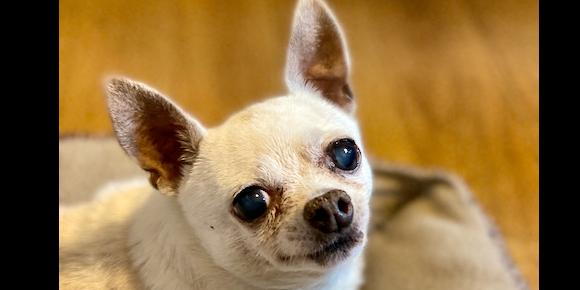
- posted: Jan. 11, 2021
Our pets are living longer. This is a great aspect of modern veterinary medicine. Most of our pet owner's understand as pets age, they can run into similar physical ailments as people can such as arthritis. But pets also can suffer from mental deterioration just as we can. Dogs and cats can run into very similar brain changes that are also seen in people with Alzheimer's. In veterinary medicine we refer to this as CDS or cognitive dysfunction syndrome. What are some signs to look for?Some pets will wander aimlessly around the house, or perhaps wander in a pattern, a circle or even get stuck in a corner. A pet that stares at the wall, or perhaps looks confused and unsure of its surroundings. A lose of house training.
We have a wonderful little Chihuahua named Cheeto. He's never been a noisy little dog. He's always been a very mellow little man. As he has aged though, some changes started to occur. First, he seemed to get his nights and days mixed up. He'd sleep very well during the day, but then would be up at night and he seemed confused as to why we were asleep. He also started to exhibit signs of anxiety. He started to whine consistently. At first, the whining started almost on the hour at 7 pm. Alzheimer's patient can exhibit "Sundowners" syndrome, where the symptoms of confusion and agitation can occur during the evening hours. This seemed to be what Cheeto was exhibiting.
First I started him on selegiline, a medication that we use for CDS in dogs. While this medication has limited success for CDS, it did help Cheeto get his days and nights straightened out, but didn't seem to curb his anxiety. I then started Cheeto on a series of medications trying to help his anxiety. He then was subjected a variety of trials from alprazolam (Xanax or a valium class drug) to trazodone. We've finally settled on what seems to have helped him consistently : CBD oil.
CDS can be treated with therapeutic diets, dietary supplements that are rich in antioxidants, and cognitive enrichment (social interactions, toys, etc.). Treatment should begin early, as the patient is more likely to respond better earlier in the course of the disease. Cheeto has been treated for at least two years, and while he's slowly down physically, he enjoys his family, his food, and he still will fight you to have his nails cut. Then the Chihuahua comes out.

